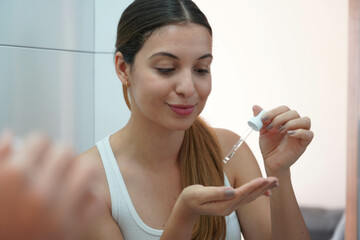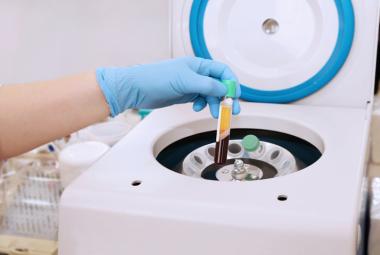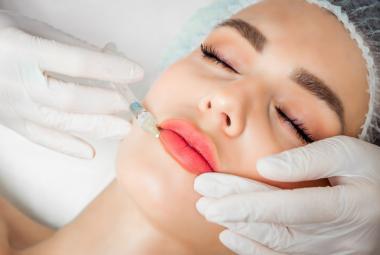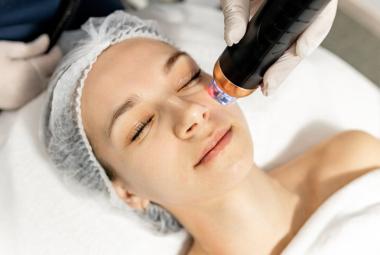What Are Retinoids?
Retinoids are a group of compounds derived from vitamin A. They work by promoting cell turnover, reducing inflammation, and clearing clogged pores. Because of their ability to influence skin cell behavior, they’re used to manage a range of concerns, including:
- Acne vulgaris (mild to severe) – Retinoids are first-line therapy for acne because of their ability to clear pores, reduce inflammation, and prevent new breakouts.
- Skin rejuvenation – Prescription options, such as tretinoin, are considered the gold-standard treatment for wrinkles and sun damage.
- Photoaging – Retinoids help improve fine lines, skin texture, and pigmentation.
- Psoriasis – Certain topical or oral retinoids are used to reduce scaling and plaque formation (Orfanos, 1997)
Vitamin A is a fat-soluble vitamin. If a mom takes excessive doses of oral vitamin A, there can be too much retinol in her milk, which can be toxic to the breastfed infant (symptoms: bulging fontanelle, irritability, vomiting, poor weight gain). However, this is rare even when a mom is taking high doses of vitamin A and would be unlikely in a breastfed infant of a mother using a topical retinoid (Bezerra, 2022).
Cosmetic vs. OTC vs. Prescription Retinoids: What’s the Difference?
A recent clinical trial in women demonstrated that lower-dose retinoids, such as retinol and its precursors, are as effective as higher-dose prescription tretinoin in improving wrinkles and other signs of photoaging, while causing significantly less skin irritation. This means that women can achieve similar anti-wrinkle benefits with over-the-counter retinoid products while minimizing redness and peeling commonly seen with stronger prescription creams (Mellody et al., 2022) .
Retinoids vary in strength, formulation, and how they work in the body. Here’s a breakdown of the most common types:
In the Beauty Aisle:
Cosmetic Retinols:
Cosmetics, including retinol-containing skin products, are regulated under different standards than drugs: they do not require premarket approval for efficacy or safety, and their labeling is limited to cosmetic claims (e.g., improving the appearance of skin) rather than disease treatment or prevention. Clinical studies are not required for marketing cosmetic formulations, and the concentrations of retinol in these products are typically lower than those in drug retinoid products (prescription or OTC), resulting in lower potency and less irritation. Cosmetic retinols will not have a “drug facts” label like OTC retinoids.
- Retinol is a naturally occurring form of vitamin A. It is less potent but generally well tolerated, making it a good choice for cosmetic use and beginners.
- Retinaldehyde is a step stronger than retinol, it converts more easily into active vitamin A in the skin and may work faster, but is still gentle and good for sensitive skin.
There are no studies on how cosmetic retinols influence milk retinol levels. However, unlike oral vitamin A doses, repeated topical application of retinol-containing products (even at high doses) do not change the blood levels of retinol, retinyl esters, or retinoic acids in females of child-bearing age. As molecules can only enter milk if they are first in the blood, we feel confident that these products won’t negatively impact a breastfed infant.
OTC Retinoids:
- OTC Adapalene 0.1% gel (Differin) is a synthetic retinoid available over-the-counter (OTC) without a prescription. It is FDA-approved to treat acne, it works more directly and is more stable than a cosmetic retinol (Reynolds, 2024). It is well tolerated and intended for spot treatment of acne when OTC. The drug is identical to products that are still prescription-only, but is mixed at a lower concentration. Products with adapalene in them will have a “Drug Facts” label.
There are no studies on topical retinoids and human milk. Like cosmetic retinol, topical retinoids do not change the blood concentration of retinols (Latriano, 1997). This means it will not change milk levels of retinols. The drug itself has low absorption (1-2%), so adapalene is unlikely to be in milk.
In the pharmacy:
Prescription-Only Topical Pharmaceutical Retinoids:
- Adapalene 0.3% (topical) is a higher concentration of the OTC version used under medical supervision for persistent acne.
- Tretinoin (topical) is one of the most commonly prescribed topical retinoids. It is more potent than OTC options and used for both acne and photoaging.
- Tazarotene (topical) is a stronger retinoid used for acne and psoriasis. It’s highly effective but more irritating than other options.
There are no studies on topical retinoids and human milk. Topical retinoids do not change the blood concentration of retinols. This means it will not change milk levels of retinols. These topically applied drugs have low absorption (<6%) into maternal blood, so the drugs themselves are also unlikely to be in milk (Bezerra, 2022) (Menter, 2000).
Over the counter options such as retinal and adapalene 0.1% are considered the lowest risk, while prescription-strength products such as tretinoin and adapalene 0.3% are still considered acceptable. Tazarotene, has a higher potency and absorption (6% vs 1-2%), and should be used with more caution. Some experts have recommended tazarotene be limited to less than 20% of body surface area when breastfeeding (Butler, 2014). However, it is not likely to be present in milk due to high protein binding.
Prescription-Only Oral Pharmaceutical Retinoids:
Oral retinoids (e.g., isotretinoin, acitretin) are taken by mouth for severe cases of acne or psoriasis. These require close medical supervision due to their systemic effects and potential risks.
Oral retinoids are NOT compatible with breastfeeding. Though there is no direct research studying the drug in breastfeeding, there are many concerns. The drugs are present in maternal blood and will probably pass in their milk. These medications are fat-soluble, which plays a major role in how they act in the body. This property allows them to spread widely through tissues, build up in fat stores, and remain in the body for a long time—especially in the case of drugs like etretinate and acitretin. Their fat solubility will probably enable them to cross biological barriers like the placenta and into breast milk. Retinoids have known risks of birth defects during pregnancy and may cause neurodevelopment effects in breastfed infants. Oral retinoids do decrease blood retinol concentrations, which could change the amount of vitamin A an infant would receive via milk (Larsen, 1992) (Nohynek, 2006).
Breastfeeding Considerations:
- Cosmetic retinols are unlikely to affect human milk or a breastfed infant. They are not regulated like drugs, so the content of the products themselves are always somewhat questionable.
- Topical retinoids, whether OTC or prescription, are generally considered safe to use while breastfeeding, as they are applied to the skin and absorbed in very small amounts. This leads to minimal levels in the bloodstream and are unlikely to pass into breast milk in significant amounts (Kochhar, 1997). Avoid applying topical retinoids to the chest area, especially the nipple or areola. There are no known adverse effects reported in breastfed infants from moms using topical retinoids (Reynolds, 2024).
- Oral retinoids are NOT recommended during breastfeeding. These drugs will probably be present in milk. Oral retinoids are not recommended for women who are pregnant or breastfeeding, as they could harm the baby. Organizations such as the American Academy of Dermatology and the National Psoriasis Foundation specifically warn against the use of oral retinoids like acitretin in pregnant and lactating women due to these risks (Larsen, 1992).
Final Thoughts
Retinoids are powerful and effective treatments for many skin conditions, but their safety during breastfeeding depends on the type used. Topical retinoids are generally safe when used properly, while oral retinoids should be avoided due to the risk of harm to the breastfed infant.
Nichole Campbell, MSN, APRN, NP-C
Katie Boatler, RN, BSN
Kaytlin Krutsch, PhD, PharmD, MBA, BCPS
References
- Bezerra DS, de Melo ATA, de Oliveira KCAN, et al. Breast Milk Retinol Levels after Vitamin A Supplementation at Different Postpartum Amounts and Intervals. Nutrients. 2022;14(17):3570. Published 2022 Aug 30. doi:10.3390/nu14173570
- Mellody KT, Bradley EJ, Mambwe B, et al. Multifaceted Amelioration of Cutaneous Photoageing by (0.3%) Retinol. International Journal of Cosmetic Science. 2022;44(6):625-635. doi:10.1111/ics.12799.
- Nohynek GJ, Meuling WJ, Vaes WH, et al. Repeated topical treatment, in contrast to single oral doses, with Vitamin A-containing preparations does not affect plasma concentrations of retinol, retinyl esters or retinoic acids in female subjects of child-bearing age. Toxicol Lett. 2006;163(1):65-76. doi:10.1016/j.toxlet.2005.09.029
- Latriano L, Tzimas G, Wong F, Wills RJ. The percutaneous absorption of topically applied tretinoin and its effect on endogenous concentrations of tretinoin and its metabolites after single doses or long-term use. J Am Acad Dermatol. 1997;36(3 Pt 2):S37-S46. doi:10.1016/s0190-9622(97)70059-8
- Latriano L, Tzimas G, Wong F, Wills RJ. The percutaneous absorption of topically applied tretinoin and its effect on endogenous concentrations of tretinoin and its metabolites after single doses or long-term use. J Am Acad Dermatol. 1997;36(3 Pt 2):S37-S46. doi:10.1016/s0190-9622(97)70059-8
- Menter A. Pharmacokinetics and safety of tazarotene. J Am Acad Dermatol. 2000;43(2 Pt 3):S31-S35. doi:10.1067/mjd.2000.108321
- Larsen FG, Nielsen-Kudsk F, Jakobsen P, Weismann K, Kragballe K. Pharmacokinetics and therapeutic efficacy of retinoids in skin diseases. Clin Pharmacokinet. 1992;23(1):42-61. doi:10.2165/00003088-199223010-00004
- Nohynek GJ, Meuling WJ, Vaes WH, et al. Repeated topical treatment, in contrast to single oral doses, with Vitamin A-containing preparations does not affect plasma concentrations of retinol, retinyl esters or retinoic acids in female subjects of child-bearing age. Toxicol Lett. 2006;163(1):65-76. doi:10.1016/j.toxlet.2005.09.029







